Study on Pressure Pulsation and Force Characteristics of Kaplan Turbine
Abstract
:1. Introduction
2. Numerical Method
2.1. General Equation
2.2. Turbulence Model
3. Numerical Settings
3.1. Computational Domain and Parameters of Kaplan Turbine
3.2. Meshes and Calculation Conditions Setting
3.3. Mesh Independence Check
3.4. Boundary Conditions and Monitoring Point Settings
3.5. Determination of Monitoring Points
4. Results
4.1. Pressure Pulsation
4.2. Vortices in the Vaneless Space
4.3. Radial Force
4.4. Axial Force
4.5. Hydraulic Torques along Blade Shank()
5. Conclusions
- 1.
- Under low flow conditions, there will be periodic vortices in the vaneless space. Under high head and low flow conditions, two vortices with phase angles nearly 180 degrees apart will form at the inlet of the runner. In a stationary coordinate system, the vortex zone rotates in the same direction as the runner with a rotating frequency of 0.5 fn. Since there are two vortex zones, the pressure pulsation frequency at the monitoring point is about 1 fn. The vaneless space under low head and low flow condition is characterized by vortices with periodic vertical fluctuations, reaching its maximum near the guide vanes and its minimum near the runner blades. The frequency of vortex fluctuations is 0.5 fn. Therefore, under low flow conditions, there will be low-frequency pressure fluctuations of 0.5–1 fn in the vaneless space affected by vortices.
- 2.
- Under high head and low flow conditions, vortices block the passage and force flow to change direction. Therefore, a low pressure zone will be generated at the vortex. As the runner rotates, the pressure value in the low pressure zone also undergoes periodic changes. The frequency of pressure change in one low pressure zone is 0.166 fn, and the frequency of pressure change in two low-pressure zones is 0.33 fn. The main frequencies of radial force fluctuations under high head and low flow conditions are 0.33 fn and 1 fn. 1 fn is caused by the rotation of two vortices and 0.33 fn is caused by periodic changes in pressure values in the two low pressure zones. Therefore, the flow asymmetry caused by vortices in the vaneless space under low flow conditions is the main reason for the large radial force of the runner.
- 3.
- Under low head and rated head, the axial force of the runner upwards continuously increases as the flow rate increases. Under high head, the axial force of the runner is less affected by the flow rate. But under each head, the fluctuation of axial force is the highest under low flow conditions. Under low flow of high head and low head conditions, low-frequency pulsation of axial force is generated due to the influence of vortices.
- 4.
- The hydraulic torques along blade shank () for six blades are unsteady, non-uniform, and asynchronous. The pulsation amplitude of increases with the increase of flow rate under rated head and low head, and the main frequency is 1 fn. However, under high head and low flow, the main frequency of is 0.333 fn, which is consistent with the main frequency of radial force, and the amplitude is the largest. The phase difference between adjacent blades under high flow conditions is 60. The two circumferential symmetrical low pressure zones under high head and low flow conditions cause uneven flow, resulting in a phase difference of 120 between adjacent blades. This state of the blade operating mechanism causes rapid damage to key components.
Author Contributions
Funding
Institutional Review Board Statement
Informed Consent Statement
Data Availability Statement
Acknowledgments
Conflicts of Interest
Abbreviations
| CFD | Computational fluid dynamics |
References
- Cui, R.G.; Guo, J.; Cheng, L.H. Status and Trends Analysis of Global Clean Energies. Acta Geosci. Sin. 2021, 42, 179–186. [Google Scholar]
- Ma, W.S. Simulation of the Whole Passage in Prototype Turbine and Analysis of Precision in Calculation; China Agricultural University: Beijing, China, 2005. [Google Scholar]
- Estevez, E.E. Comportament Dinàmic de Màquines Hidràuliques; Universitat Politècnica de Catalunya: Barcelona, Spain, 2004. [Google Scholar]
- Wu, S.F.; Wu, Y.L.; Liu, C.H. The characteristics prediction and the operating comprehensive performance curve drawing of Kaplan turbine. J. Hydroelectr. Eng. 2008, 27, 121–125. [Google Scholar]
- Liu, X.; Luo, Y.Y.; Wang, Z.W. A review on fatigue damage mechanism in hydro turbines. Renew. Sustain. Energy Rev.. 2016, 54, 1–14. [Google Scholar] [CrossRef]
- Zhou, L.J.; Wang, Z.W.; Xiao, R.F. Analysis of dynamic stresses in Kaplan turbine blades. Eng. Comput. 2007, 24, 753–762. [Google Scholar] [CrossRef]
- Liu, S.; Li, S.; Wu, Y. Pressure fluctuation prediction of a model Kaplan turbine by unsteady turbulent flow simulation. Fluids Eng.. 2009, 131, 101102. [Google Scholar] [CrossRef]
- Rodriguez, C.G.; Egusquiza, E.; Santos, I.F. Frequencies in the vibration induced by the rotor stator interaction in a centrifugal pump turbine. Fluids Eng. 2007, 129, 1428–1435. [Google Scholar] [CrossRef] [Green Version]
- Jonsson, P.P.; Mulu, B.G.; Cervantes, M.J. Experimental investigation of a Kaplan draft tube-Part II: Off-design conditions. Energy 2012, 94, 71–83. [Google Scholar] [CrossRef]
- Amiri, K.; Mulu, B.; Raisee, M. Load variation effects on the pressure fluctuations exerted on a Kaplan turbine runner. IOP Conf. Ser. Earth Environ. 2014, 22, 32005. [Google Scholar] [CrossRef]
- Motycak, L.; Skotak, A.; Kupcik, R. Kaplan turbine tip vortex cavitation-analysis and prevention. IOP Conf. Ser. Earth Environ. Sci. 2012, 15, 32060. [Google Scholar] [CrossRef] [Green Version]
- Kumar, P.; Saini, R.P.; Cheng, L.H. Study of cavitation in hydro turbines—A review. Renew. Sustain. Energy Rev. 2010, 14, 374–383. [Google Scholar] [CrossRef]
- Wang, Z.W.; Luo, Y.Y.; Zhou, L.J. Computation of dynamic stresses in piston rods caused by unsteady hydraulic loads. Eng. Fail. 2008, 15, 28–37. [Google Scholar] [CrossRef]
- Urquiza, J.; Garcia, J.C.; Gonzalez, J.G. Failure analysis of a hydraulic Kaplan turbine shaft. Eng. Fail. 2014, 41, 108–117. [Google Scholar] [CrossRef]
- Luo, Y.Y.; Wang, Z.W.; Zeng, J. Fatigue of piston rod caused by unsteady, unbalanced, unsynchronized blade torques in a Kaplan turbine. Eng. Fail. 2010, 17, 192–199. [Google Scholar] [CrossRef]
- Liu, S.; Shao, J.; Wu, S. Numerical simulation of pressure fluctuation in Kaplan turbine. Sci. China Ser. E-Technol. Sci. 2008, 51, 1137–1148. [Google Scholar] [CrossRef]
- Wu, Y.; Liu, S.; Dou, H. Numerical prediction and similarity study of pressure fluctuation in a prototype Kaplan turbine and the model turbine. Comput. Fluids 2012, 56, 128–142. [Google Scholar] [CrossRef]
- Zhang, Y.; Chen, T.; Li, Z. Experimental Study of Load Variations on Pressure Fluctuations in a Prototype Reversible Pump Turbine in Generating Mode. J. Fluids Eng. Trans. ASME. 2017, 139, 074501. [Google Scholar] [CrossRef]
- Zhou, L.J. Flow Field Simulation and Property Prediction for Hydraulic Turbine Runner; China Agricultural University: Beijing, China, 1999. [Google Scholar]
- Ruprecht, A.; Heitele, M.; Helmrich, T. Numerical Simulation of a Complete Francis Turbine including Unsteady Rotor/Stator Interactions; IAHR: Madrid, Spain, 2000. [Google Scholar]
- Li, G.F.; Lu, C. Experiment on pressure fluctuation of Kaplan turbine with low specific speed. J. Drain. Irrig. Mach. 2017, 35, 869–873. [Google Scholar]
- Gao, M. Experiment on pressure fluctuation of Kaplan turbine with low specific speed. New Technol. New Prod. China 2018, 13, 61–62. [Google Scholar]
- Zhu, G.J.; Li, K.; Feng, J.J. Influence of cavitation on pressure fluctuation of draft tube and runner vibration of Kaplan turbine. Trans. Chin. Soc. Agric. Eng. 2021, 37, 40–49. [Google Scholar]
- Kim, H.; Rakibuzzaman, M.; Kim, K. Flow and Fast Fourier Transform Analyses for Tip Clearance Effect in an Operating Kaplan Turbine. Energies 2019, 12, 264. [Google Scholar] [CrossRef] [Green Version]
- Wu, Y.; Feng, J.J.; Wu, G.K. Study on effects of hub clearance flow on Kaplan turbine performance. J. Hydroelectr. Eng. 2014, 33, 185–190. [Google Scholar]
- Petit, O.; Nilsson, H.; Vu, T. The flow in the U9 Kaplan turbine–preliminary and planned simulation using AND openfoam. In Proceedings of the 24th IAHR Symposium on Hydraulic Machinery and Systems, Foz Do Iguassu, Brazil, 27–31 October 2008. [Google Scholar]
- Vu, T.C.; Shyy, W. Performance Prediction of Viscous Flow Analysis for Francis Turbine Runner. J. Fluids Eng. 1994, 116, 116–120. [Google Scholar] [CrossRef]
- Vu, T.C.; Heon, K.; Shyy, W. An Integrated CFD Tool for Hydraulic Turbine Efficiency Prediction. In Proceedings of the 5th International Symposium of Refined Flow Modeling and Turbulence Measurements, Paris, France, 7–10 September 1993. [Google Scholar]
- Gehrer, A.; Schmidl, R.; Sadnik, D. Kaplan turbine runner optimization by numerical flow simulation (CFD) and an evolutionary algorithm. In Proceedings of the 23rd IAHR Symposium on Hydraulic Machinery and Systems, Yokohama, Japan, 17–21 October 2006. [Google Scholar]
- Shingai, K.; Katayama, K.; Shimmei, K. Optimization of axial turbine runner blade using a simulated annealing algorithm. In Proceedings of the 23rd IAHR Symposium on Hydraulic Machinery and Systems, Yokohama, Japan, 17–21 October 2006. [Google Scholar]
- Escaler, X.; Egusquiza, E.; Farhat, M. Detection of cavitation in hydraulic turbines. Mech. Syst. Signal Process. 2006, 20, 983–1007. [Google Scholar] [CrossRef] [Green Version]
- Thiery, F.; Gustavsson, R.; Aidanpää, J. Dynamics of a misaligned Kaplan turbine with blade-to-stator contacts. Int. J. Mech. Sci. 2015, 99, 251–261. [Google Scholar] [CrossRef]
- Zhou, X.; Shi, C.; Miyagawa, K. Investigation of Pressure Fluctuation and Pulsating Hydraulic Axial Thrust in Francis Turbines. Energies 2020, 13, 17347. [Google Scholar] [CrossRef] [Green Version]
- Luo, Y.Y. Study on Flow Induced Structure Dynamic Characteristics for Kaplan Turbine; Tsinghua University: Beijing, China, 2010. [Google Scholar]
- Yakhot, V.; Orszag, S.A. Renormalization group analysis of turbulence–I: Basic Theory. Sci. Comput. 1986, 1, 3–51. [Google Scholar] [CrossRef]
- Speziale, C.G.; Thangam, S. Analysis of a RNG based turbulence model for separated flows Int. Eng. Sci. 1992, 30, 1379–1388. [Google Scholar]
- Menter, F.R. Zonal Two-Equation k-ω Turbulence Model for Aerodynamic Flows; AIAA Paper; American Institute of Aeronautics and Astronautics: Reston, VA, USA, 1993. [Google Scholar]
- Menter, F.R. Two-equation eddy-viscosity turbulence models for engineering applications. AIAA J. 1994, 32, 1598–1605. [Google Scholar] [CrossRef] [Green Version]

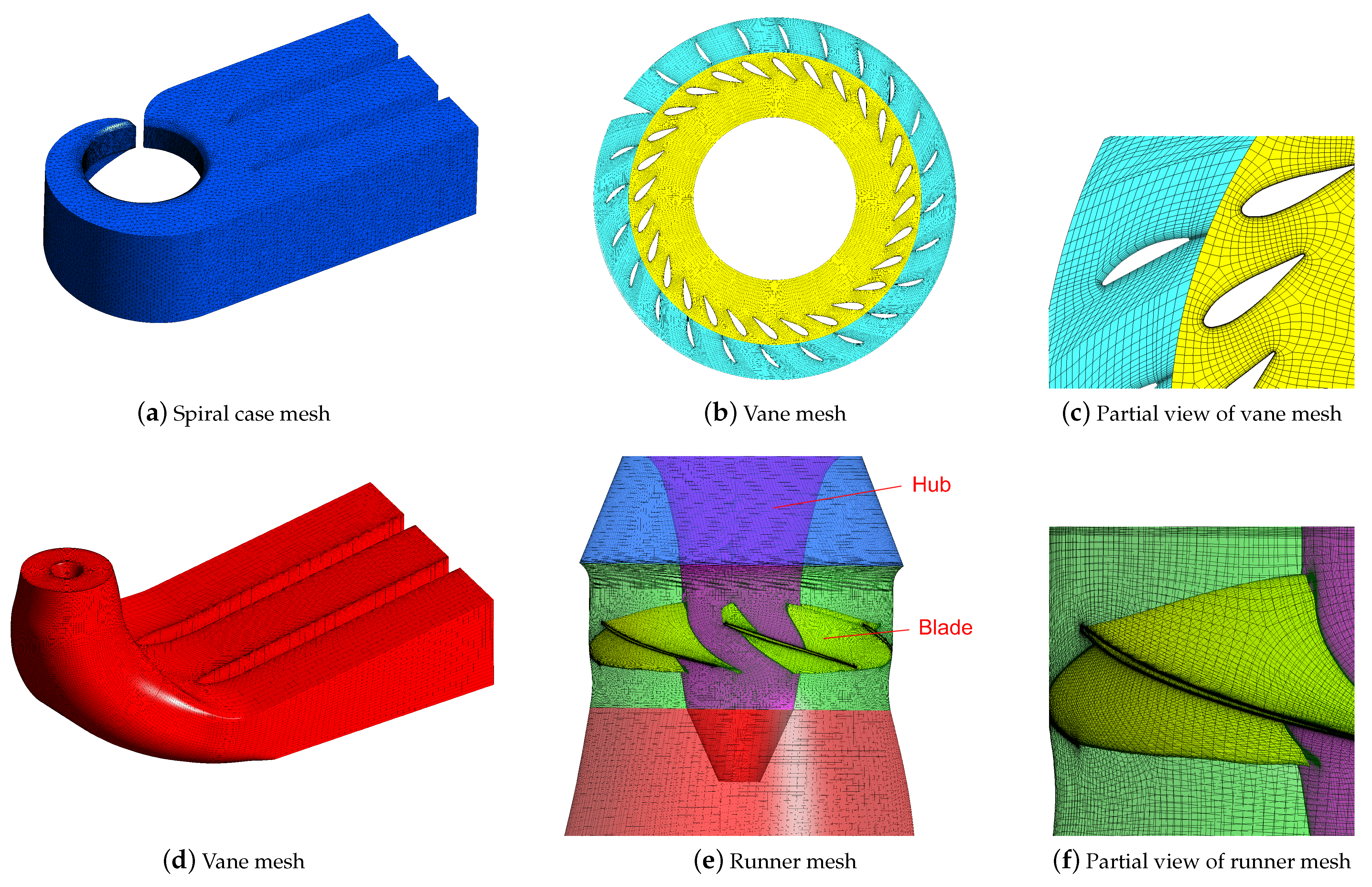



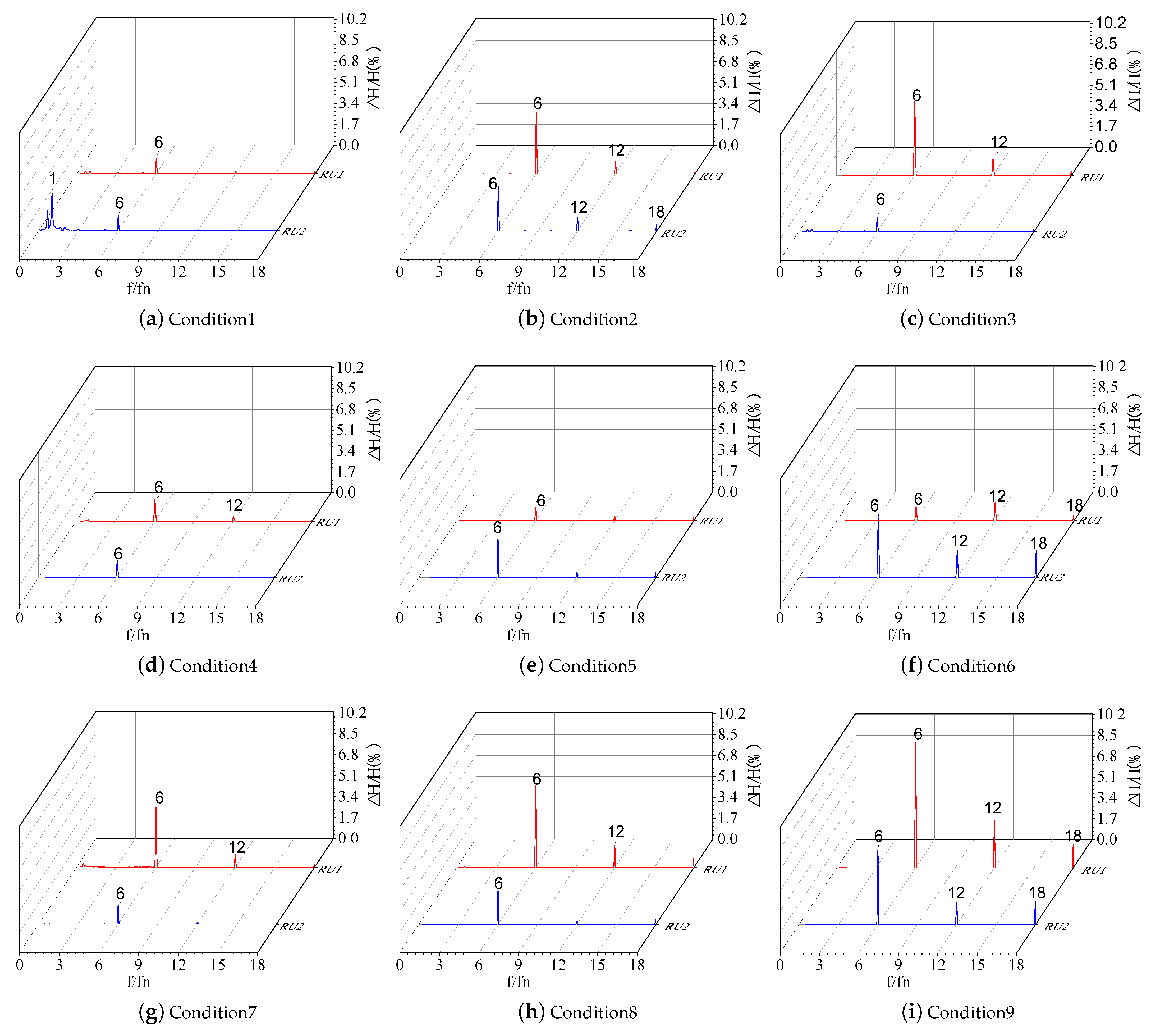
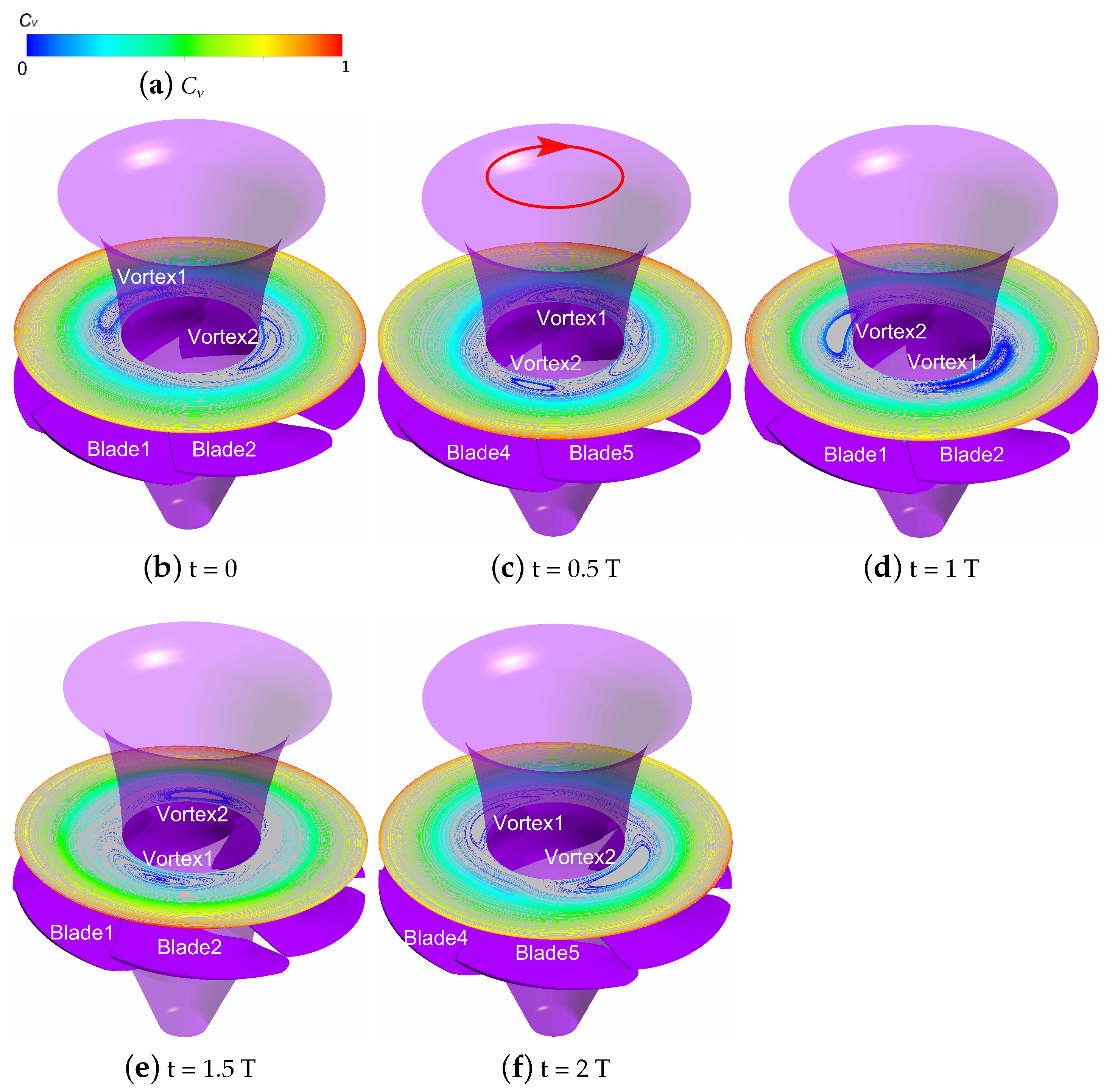



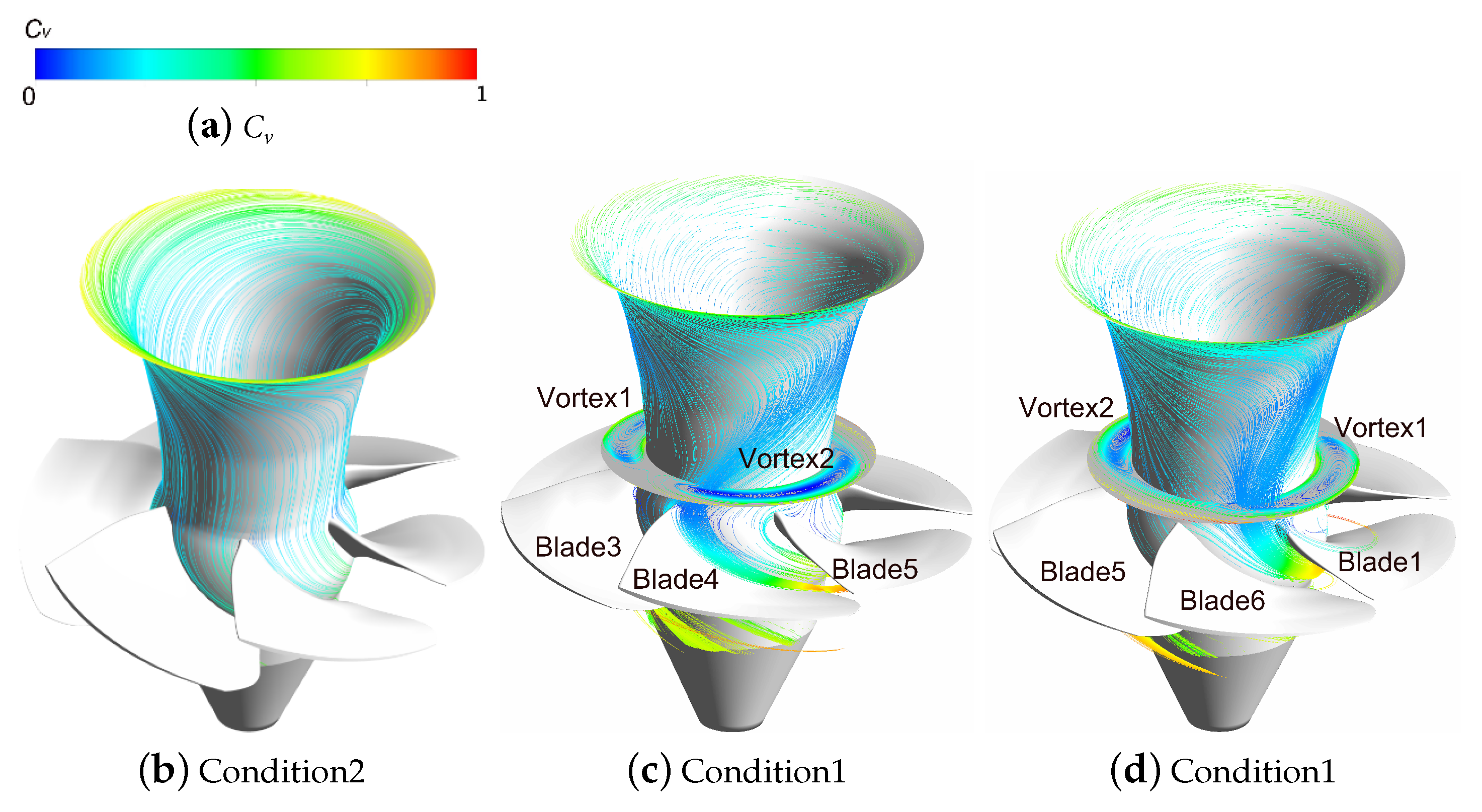
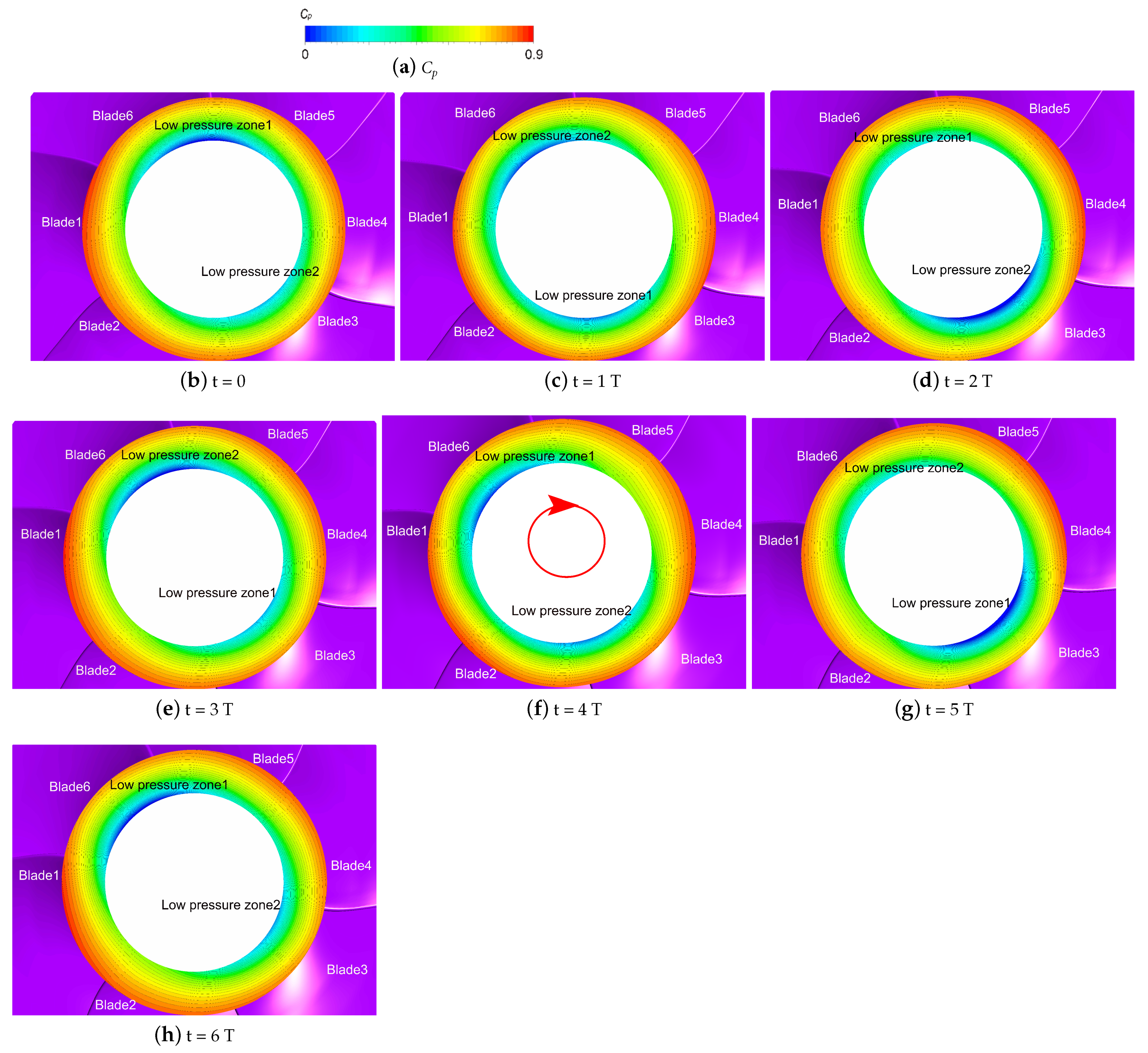




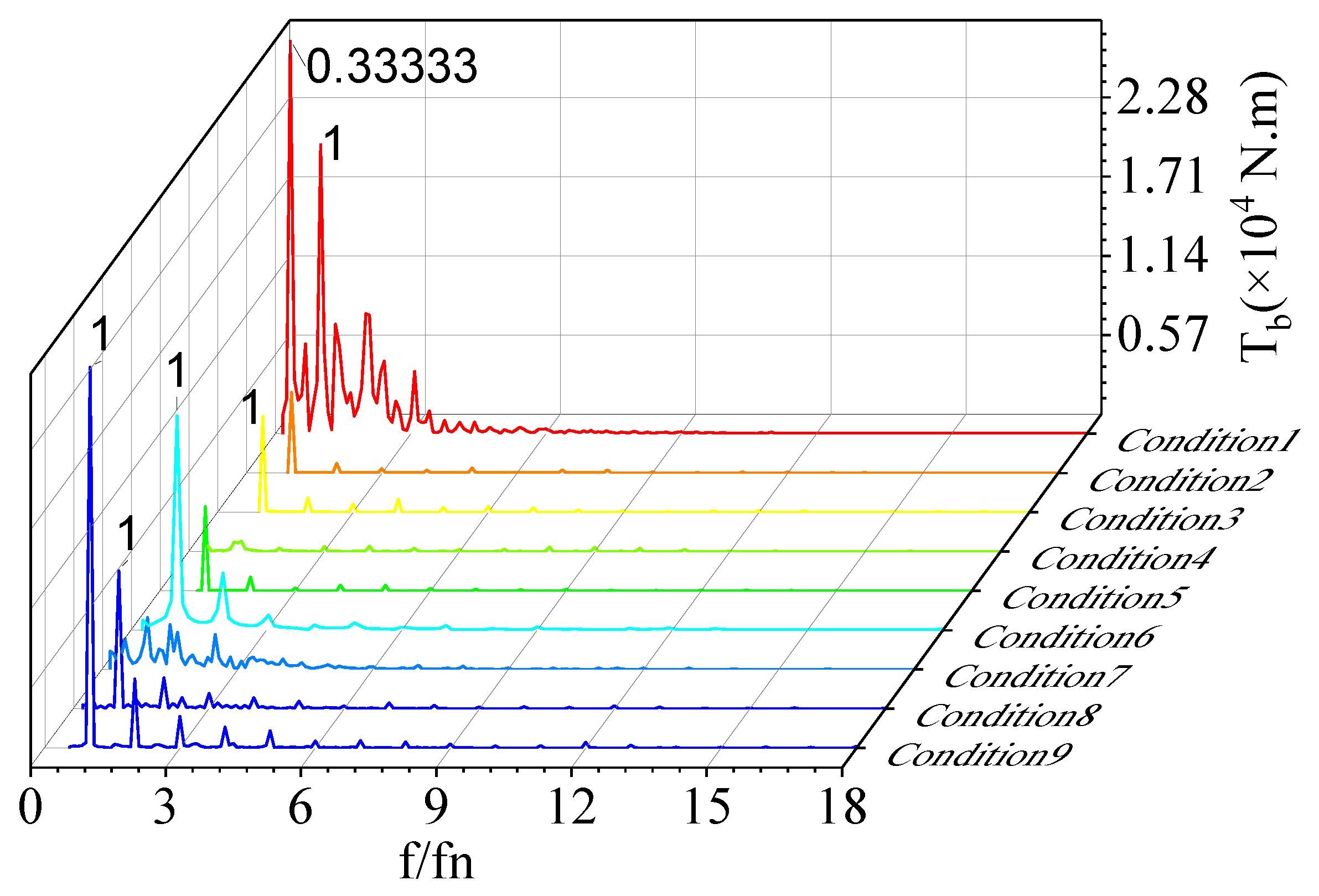
| Prototype Turbine | Value |
|---|---|
| Rotating speed of the rotor n | 68.2 r/min |
| Number of stay vanes Zs | 25 |
| Number of guide vanes Zg | 28 |
| Number of blades Zr | 6 |
| Diameter of the rotor D | 10.4 m |
| Rated head Hr | 25 m |
| Spiral Case | Stay Vane | Guild Vane | Runner | Draft Tube | Total | Efficiency | |
|---|---|---|---|---|---|---|---|
| set1 | 31 | 23 | 63 | 185 | 27 | 329 | 91.03% |
| set2 | 60 | 30 | 61 | 235 | 58 | 444 | 92.03% |
| set3 | 77 | 35 | 90 | 248 | 83 | 533 | 92.81% |
| set4 | 101 | 45 | 132 | 295 | 104 | 677 | 92.86% |
| Field measurement | 93.02% |
| Head | Condition | Blade Angle () | Angle of Guide Vane () | Flow Rate (m/s) |
|---|---|---|---|---|
| 37.79 m (maximum head) | 1 | −15.693 | 17.83 | 290.8 (Low flow) |
| 2 | −4.959 | 25.152 | 565.2 (Medium flow) | |
| 3 | −0.995 | 27.428 | 669.2 (high flow) | |
| 25 m (rated head) | 4 | −14.289 | 21.843 | 301.8 (Low flow) |
| 5 | −4.959 | 31.388 | 554.5 (Medium flow) | |
| 6 | 7.344 | 44.306 | 930.6 (high flow) | |
| 12.91 m (minimum head) | 7 | −13.381 | 34.949 | 325.9 (Low flow) |
| 8 | −4.959 | 46.193 | 552.2 (Medium flow) | |
| 9 | 4.454 | 56.826 | 828.3 (high flow) |
Disclaimer/Publisher’s Note: The statements, opinions and data contained in all publications are solely those of the individual author(s) and contributor(s) and not of MDPI and/or the editor(s). MDPI and/or the editor(s) disclaim responsibility for any injury to people or property resulting from any ideas, methods, instructions or products referred to in the content. |
© 2023 by the authors. Licensee MDPI, Basel, Switzerland. This article is an open access article distributed under the terms and conditions of the Creative Commons Attribution (CC BY) license (https://creativecommons.org/licenses/by/4.0/).
Share and Cite
Liu, C.; Chen, T.; Kang, W.; Kang, J.; Zhou, L.; Tao, R.; Wang, Z. Study on Pressure Pulsation and Force Characteristics of Kaplan Turbine. Water 2023, 15, 2421. https://doi.org/10.3390/w15132421
Liu C, Chen T, Kang W, Kang J, Zhou L, Tao R, Wang Z. Study on Pressure Pulsation and Force Characteristics of Kaplan Turbine. Water. 2023; 15(13):2421. https://doi.org/10.3390/w15132421
Chicago/Turabian StyleLiu, Chengming, Tao Chen, Wenzhe Kang, Jianjun Kang, Lingjiu Zhou, Ran Tao, and Zhengwei Wang. 2023. "Study on Pressure Pulsation and Force Characteristics of Kaplan Turbine" Water 15, no. 13: 2421. https://doi.org/10.3390/w15132421





